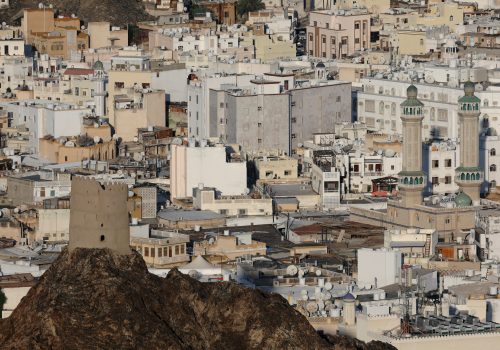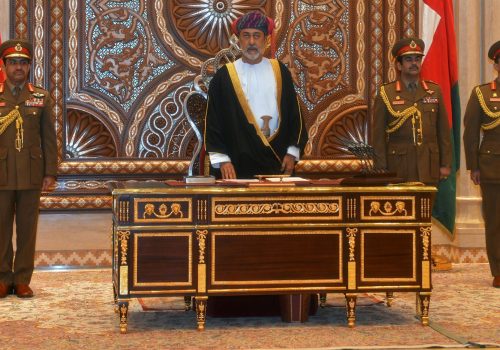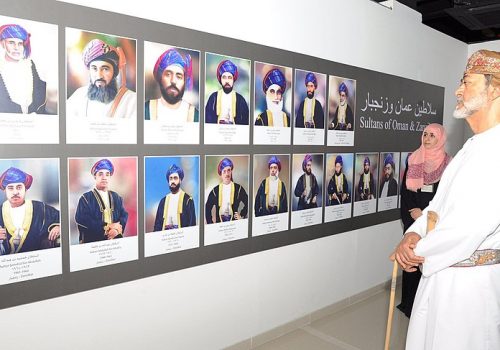After the coronavirus and low oil prices, Oman’s future is more global
It has been a busy year for the new sultan of Oman.
On January 11, Haitham bin Tarak succeeded Sultan Qaboos bin Said, a regional giant who used the country’s energy wealth to transform Oman from a rural and diplomatic backwater into a modern and developed regional power broker. Haitham’s foreign ministry experience and leadership of Oman’s latest economic reforms indicate a similar penchant for pragmatic evolution and regional peace.
Yet, with the onset of COVID-19 and an economic crisis that is bound to accelerate history, Oman’s commitment to steady progress and political neutrality will face new tests and leverage the country’s wider global relationships.
The regional approach that earned Qaboos such international standing—notably during the Barack Obama administration—was underpinned by generous domestic infrastructure and human capital investments that drove growth and maintained stability during a decade of high oil prices. But, since 2014, softer prices have weighed on the budget and it was soon clear across the region that oil’s weakness is now structural; hence, the Vision 2040 transformation program to diversify the economy and kick-start non-oil growth.
Oil revenues are now set to plunge further in 2020 after the pandemic set off a massive wave of declining global demand. Oman’s budget breaks even at almost $87 per barrel, so sub-$30 oil, coupled with a lower production quota under the April OPEC+ deal, will imply a gaping budget deficit of almost 17 percent in 2020.
Oman already entered the crisis in a weaker fiscal position than its richer Gulf Cooperation Council (GCC) neighbors, who have more room to maneuver in the short term with cash reserves and access to capital markets. Only Bahrain is worse off—and it benefits from Saudi and Emirati aid. Oman’s credit rating limits its room to borrow and, unlike Bahrain, it has studiously avoided political subservience to Riyadh or Abu Dhabi despite pressure to take sides in the region. That pressure has been building since the middle of the decade.
With the rise of Saudi Arabia’s Mohammed bin Salman, the UAE’s Mohammed bin Zayed, and US President Donald Trump, Oman was subject to the activist foreign policies of the two crown princes and a cooler reception in Washington during Qaboos’ final years. Relations with the UAE are particularly sensitive in Oman, and efforts to triangulate between Riyadh and Abu Dhabi are limited by the princes’ aggressive style and an Omani desire to mediate rather than participate in regional conflicts, such as Yemen and the GCC feud with Qatar.
In this new environment of soft-isolation in the neighborhood, cooler relations with Washington, and economic change, Oman has been deftly cultivating important relationships outside the GCC—particularly with China, India, and Europe. Energy connectivity and technology investments are defining elements of each and will help drive the country’s economic recovery.
Chinese money and US warships
Oman’s strategic position as a logistics hub is both a cornerstone of Vision 2040 and an attractive asset for China’s Belt and Road Initiative (BRI) infrastructure mega-plan. The port of Duqm emerged in 2016 as a flagship hub. Buoyed by a $265m loan from the Beijing-based Asian Infrastructure Investment Bank (AIIB) to expand the port, Oman Wanfang, a consortium of Chinese investment firms, signed a $10.7 billion deal to construct an industrial park in the Duqm Special Economic Zone designated by the Omani government. Progress on the twelve thousand square-meter Chinese site has fallen far short of expectations, but the project is still a sign of China’s commitment to Oman as a BRI gateway to Arabia. In December 2019, China’s State Grid bought 49 percent of Oman’s power grid, followed by a major deal for Saudi Arabian smart meters, and the AIIB’s first financing of renewable energy in the GCC for Oman’s Ibri II project.
The United States has noticed Duqm as well, not as an economic opportunity, but as a military base capable of supporting aircraft carriers. Despite the Trump administration’s tempered interest in Oman’s role as a regional facilitator, its strategic location is valuable as tensions flare with Iran. Last March, the Pentagon secured access to Duqm for its warships.
The coronavirus pandemic and 2020 economic depression puts Oman under even more pressure to transition its economy and court foreign capital. S&P expects that Oman’s external debt will rise to 67 percent—from about 20 percent in 2018—of current account receipts in 2023. Faced with rising costs of debt and borrowing, spending is being reined in by over 10 percent with cuts to infrastructure and future investments. But capex counts for only a small slice of the budget—services, salaries, and social programs may be next. Sultan Haitham has already announced plans to streamline government administration (starting with cutting down on expensive advisors), but he will be conscious of Oman’s societal vulnerabilities in the face of deteriorating economic conditions at home and will be looking for cash. Previous plans to further divest from semi-state owned Petroleum Development Oman (PDO) are back on the front burner, which may improve the country’s credit ratings and ease borrowing on international capital markets.
But, whether loans come from regional neighbors or the International Monetary Fund, they come with strings. China, with cash on hand and an established investment program to allocate it, may find great deals on distressed Omani assets. Existing debt coming due in 2021-2022 includes $3.5 billion in Chinese loans. Any lenience will be wrapped up in China’s wider approach to debt relief along the Belt and Road, giving Beijing additional leverage. The Omani government is conscious of overreliance on China and the US navy might provide a counterweight at Duqm, but the power grid sale shows that critical infrastructure is available for the right price. Oman will face a delicate balancing act as decoupling accelerates between the two global powers.
India, Europe, and energy beyond oil
Other regional powers, like India, also sense opportunities. In December 2019, New Delhi signed a maritime transport agreement with Oman, the first with any Gulf country. The pact helps India to advance its Indo-Pacific strategy and reinforces Oman’s role as a hub for Indian shipping. The Indian navy also acquired access to Duqm and Indian companies have been investing in its special economic zone, where a joint consortium is undertaking a $1.2 billion project to build a large sebacic acid bio-refinery plant. In the medium term, India can also provide a market for Omani LNG, with its pre-COVID-19 demand rising faster than China’s. Currently, only about 10 percent of exported Omani gas goes to India, but when Oman’s primary contract with Korean KOGAS expires in less than five years, India will be a willing buyer.
The Omani-Indian relationship is a long-standing one and the two have long discussed various interconnection and trade plans. Historic ties, an established Indian business community in Oman—with access to capital and markets on the sub-continent—and Prime Minister Narendra Modi’s strategic imperatives in a post-coronavirus multi-polar region are likely to bring these two countries even closer.
Finally, European countries see Oman as a natural partner in the region and have been actively cultivating the relationship. The effort is especially necessary after Brexit—Oman has kept close ties to the United Kingdom, which provides the bulk of foreign development finance and holds a unique place in the hearts of the Omani elite (both Qaboos and Haitham spent their formative years among the British establishment). Continental Europeans are now playing catch-up, drawn to Oman by similar diplomatic priorities and a common distaste for the recent approaches from Riyadh, Abu Dhabi, and Washington. Europe appreciates Oman’s resiliency in the face of regional polarization and the European Union is already the largest contributor of foreign direct investment into the country.
European investment might also cultivate a unique green energy partnership. In March, Belgian firm DEME announced plans to build up to 500 MW of solar and wind-powered green hydrogen capacity at Duqm despite the ongoing pandemic. With green spending and hydrogen at the heart of Europe’s large post-COVID-19 stimulus packages, Oman could provide a unique investment destination to strengthen green energy imports and bolster the weak European presence in the Gulf post-Brexit.
In the midst of economic crisis, Oman stands out among its GCC neighbors. The country no longer enjoys the regional clout and economic comfort it felt only a few years ago, and those trends have pushed it to diversify its relationships and cultivate new investments. The COVID-19 economic crisis will accelerate that process. Advanced energy projects and connectivity already play an important part in Oman’s expanding global relationships. They can also provide an investment pathway to mitigate the economic crisis, underpin a more robust recovery, and drive energy sector diversification in the context of volatile oil markets and finite reserves. The new posture may not ease tensions with its erstwhile GCC and American allies, and the new sultan has already expressed preference for cooperative economic diplomacy over pushy military overtures. But strained US relations are seen with alarm in Muscat and, while Washington’s plans to send carrier fleets are less attractive than sorely needed investments and loans, ongoing engagement is both welcome in the Sultanate and aligned with US geopolitical interests. Concessionary financing in the recovery phase and supporting technology investments could boost the US position in this increasingly contested entrepôt—expanding the Asia EDGE program west to Oman could be a good start.
In a multi-polar post-COVID-19 world, contests for influence in countries like Oman will be economic and technological and focused on critical infrastructures, with geostrategic rewards.
Phillip Cornell is a senior fellow at the Atlantic Council’s Global Energy Center. He was previously a senior corporate planner at Saudi Aramco and senior advisor to the International Energy Agency. Follow him on Twitter: @pcornell10.
Image: The logo of Oman Drydocks Company is seen on a crane at Duqm Port, Oman, August 22, 2017. Picture taken August 22, 2017. REUTERS/ Nawied Jabarkhyl


